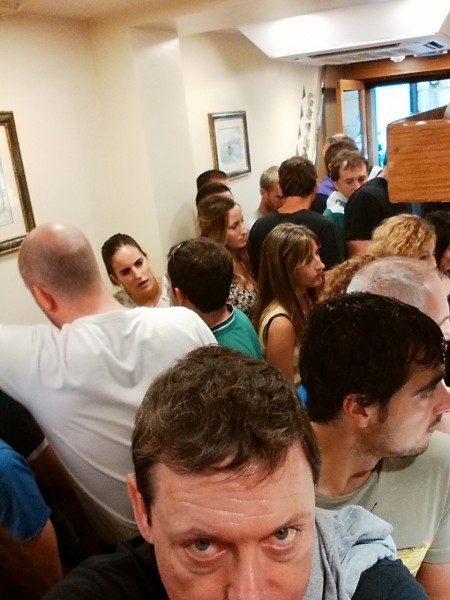First, watch this video titled ‘Humans Need Not Apply’.
Now answer this question: what would happen when all jobs that humans perform today will be automated?
The scenario of nobody having a job might seem fancy and theoretical at first, but it’s becoming more realistic with each passing day. Google, Uber, BMW, and a lot of other organizations are on track to release self driving vehicles as soon as next year. And as the video demonstrates so beautifully, this is not just happening to the transportation industry. Automation will impact every sphere of human activity – be it creative, mechanical, cognitive or managerial.
We live in a world of machine learning, APIs, exponentially improving technology, billion dollar disruptions. A lot of such innovations are about making humans redundant.
What will millions of jobless people do?
Taking transportation as an example again, as self-driving cars become commonplace we will rapidly have millions of jobless drivers who are unskilled. As manual labor gets replaced with automation and machines, such unskilled people would find it increasingly difficult find other jobs. Even if they get skilled, gradually automation will reduce the number of jobs available for skilled people. I concur with the video that this wave of people with no jobs will swell into a huge tsunami. Are governments prepared to handle this? In the short term, this will have a very real impact of worsening standard of living for a lot of people. They simply wouldn’t have any money to pay for even basic stuff.
What governments need to do?
Automation leads to concentration of wealth into certain corporations and individuals. A single innovation in automation by a specific company or individual can replace thousands and millions of jobs. Where income earlier used to go to many people doing the job, now the same (somewhat reduced) income will go to one company that developed that specific automation. This concentration of wealth will be sharper because of the network effects (the winner takes it all) and rich getting richer. Consider how Google is using technology to swell its cash reserves and revenues quarter after quarter. If earlier many thousands of cartographers used to get paid to map cities, now Google can just pay for fuel and have its self-driving car + maps software to automatically generate city maps at a detail no human cartographer can match.
Governments will eventually realize the irony of companies like Apple and Google having billions in cash reserves while millions being jobless due to no fault of their own and being unable to afford basic amenities of life. Governments could realize this fact by themselves or protests, activism or even vandalism can make them wake up to this fact.
Higher taxation and “Citizen wage”
As wealth gap increases (more so due to automation concentrating wealth in some hands), governments will have to step in to rectify the situation. I side with the (semi-popular) view of higher corporate and individual taxation. The taxes that are collected from wealthy firms will go back to individual citizens as a wage just for existing. Consider citizen wage like a basic income that everyone gets from the government. This re-distribution of wealth from wealthy corporations to individuals will be justified because lack of jobs is a situation that corporations created. Poverty is not a choice people opt for.
Will higher taxes stifle innovation?
The main argument about capitalism is that it promotes innovation. The lure of money leads people to compete, innovate and provide better services. If taxes are high, why would any corporation care to bring new products in the market? If a government guarantees a good standard of living to everyone for free, why would anyone do anything? Won’t this lead to a lazy, complacent society?
I doubt that people will get lazy. Individuals drive corporations and individuals are typically driven much more by non-monetary factors like satisfaction and having an impact on society. Think Elon Musk, Steve Jobs, Larry Page – are they doing this for money or they’re doing this for their own satisfaction? Imagine if everyone is satisfied with a basic standard of living, won’t people come together and still innovate because they like innovating? In fact, if we take money out of the equation and have some other metric to track individual and societal progress, it may increase overall happiness and accelerate the pace of innovation because everyone will be guaranteed a decent standard of living, so people can do what they’re best at without worrying about how they’re going to pay for dinner. Think of all the poets who are forced to drive taxis.
Co-operation between countries
Countries are increasingly interdependent for their economies. Outsourcing of services and manufacturing has left many countries dependent on exports. What would happen when automation causes some countries to become self sufficient? Take India’s scenario – millions of young engineers are dependent on outsourcing of IT services and BPO, both of which are easy targets for automation. This would lead to disproportionate job losses in India. Same would happen to China if manufacturing cost due to automation gets cheaper than the human labor.
Even if one country recognises the inevitability of automation and gives its citizens a wage for existing, other governments might not be in agreement and their citizens will suffer (due to automation-led job losses). I’m not sure if any outside government would be concerned about loss of jobs in India due to automation. India would have to tackle this problem by itself. This tackling could happen in two ways: one is to recognise that automation is real and is here to stay. This means establishing “citizen wage” (just like other governments are doing). The other way for government would be to shut its door to all “imported” automation. This is a very real possibility – there are potentially hundreds of millions of jobs stake and some countries (like India) that are very labour driven could succumb to this. This “banning” of automation will make some countries go backward, become more and more inefficient and less productive, while other countries march forward, becoming more and more productive.
We will reach there
Automation is a strong force and I think the possibility of most human jobs getting automated is very real. This would lead to citizen wage, where people will work whatever they feel interested in, rather than being forced to work in order to survive. However, in the interim, as pointed out in this reddit thread, there will be chaos. In some countries, it might take vandalism and violence to drive home the point. Others might just handle this very smoothly. A perfect outcome requires individuals, corporations and governments work together and admit that basic human survival is at stake.
Possibly related posts (automagically generated):
- Why is Artificial Intelligence DEAD?
- 10 Blogs Indian Entrepreneurs Must Regularly Visit
- Future predictions about Me












